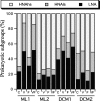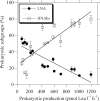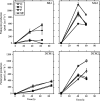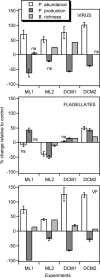Viral and flagellate control of prokaryotic production and community structure in offshore Mediterranean waters
- PMID: 19465525
- PMCID: PMC2708420
- DOI: 10.1128/AEM.01376-08
Viral and flagellate control of prokaryotic production and community structure in offshore Mediterranean waters
Abstract
A dilution and size fractionation approach was used to study the separate and combined effects of viruses and flagellates on prokaryotic production ([(3)H]leucine incorporation) and community composition (16S rRNA gene PCR and denaturing gradient gel electrophoresis [DGGE]) in the upper mixed layer and the deep chlorophyll maximum in the offshore Mediterranean Sea. Four experiments were established using differential filtration: a resource control without predators (C treatment), treatment in the presence of viruses (V treatment), treatment in the presence of flagellates (F treatment), and treatment in the presence of both predators (VF treatment). The V and VF treatments increased prokaryotic abundance (1.4- to 2.3-fold) and the number of DGGE bands (by up to 43%) and decreased prokaryotic production compared to the level for the C treatment (by 22 to 99%). For the F treatment, significant differences compared to the level for the C treatment were found as well, but trends were not consistent across experiments. The relative abundances of the high-nucleic-acid subgroups of prokaryotes with high scatter (HNAhs) in flow cytometer settings were lower in the V and VF treatments than in the C and F treatments. These differences were probably due to lysis of very active HNA prokaryotes in the V and VF treatments. Our results indicate that the presence of viruses or viruses plus flagellates sustains prokaryotic diversity and controls prokaryotic production by regulating the proportion of the highly active members of the community. Our data also suggest that lysis and grazing control influences the relationship between bacterial community composition and prokaryotic production.
Figures







References
-
- Alonso-Saez, L., J. Aristegui, J. Pinhassi, L. Gomez-Consarnau, J. M. Gonzalez, D. Vaqué, S. Agusti, and J. M. Gasol. 2007. Bacterial assemblage structure and carbon metabolism along a productivity gradient in the NE Atlantic Ocean. Aquat. Microb. Ecol. 46:43-53.
-
- Amon, R. M. W., and R. Benner. 1994. Rapid cycling of high-molecular-weight dissolved organic matter in the ocean. Nature 369:549-552.
-
- Arrieta, J.-M., M. G. Weinbauer, C. Lute, and G. J. Herndl. 2004. Response of bacterioplankton to iron addition in the Southern Ocean. Limnol. Oceanogr. 49:799-808.
-
- Arrieta, J. M., and G. J. Herndl. 2002. Changes in bacterial β-glucosidase diversity during a coastal phytoplankton bloom. Limnol. Oceanogr. 47:594-599.
-
- Binder, B. 1999. Reconsidering the relationship between virally induced bacterial mortality and frequency of infected cells. Aquat. Microb. Ecol. 18:207-215.
Publication types
MeSH terms
Substances
LinkOut - more resources
Full Text Sources

